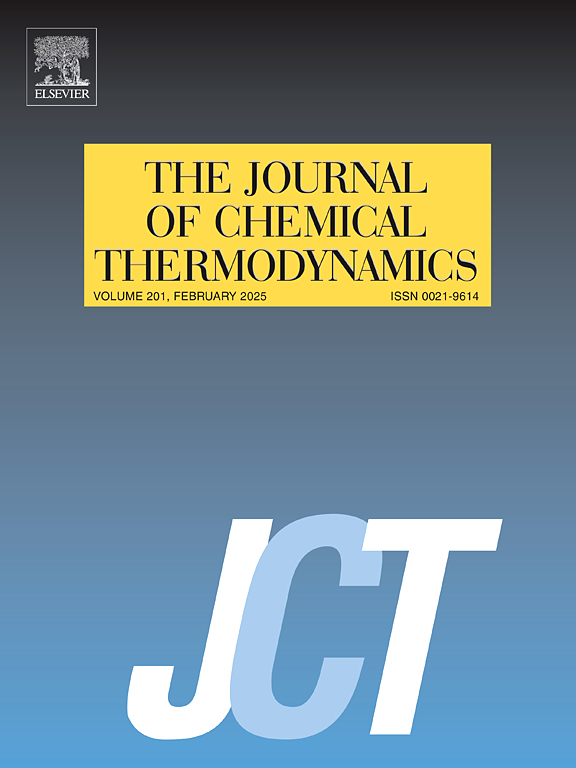基于机器学习密度预测的γ-丁内酯-二甲基甲酰胺体系中分子相互作用的实验和分子动力学研究
IF 2.2
3区 工程技术
Q3 CHEMISTRY, PHYSICAL
引用次数: 0
摘要
二元溶剂混合物因其提高反应速率、改变溶解度和优化分离工艺的能力而日益重要。在这些混合物中,γ-丁内酯(GBL)和二甲基甲酰胺(DMF)因其在各种应用领域的多功能性而备受关注,包括制药,涂料和粘合剂。本研究将实验方法与分子动力学模拟和机器学习技术相结合,研究了GBL-DMF二元体系在不同温度和组成下的物理化学性质和分子间相互作用。利用二元混合物的测量密度(ρ)、声速(u)和折射率(nD)计算了过量摩尔体积(VmE)、过量等熵可压缩性(κsE)和折射率偏差(∆∅nD),从而概述了分子之间的相互作用,表明存在强烈的分子相互作用,如氢键和偶极-偶极力。这些观察结果被分子动力学模拟进一步证实,与实验数据吻合得很好。此外,机器学习算法,包括随机森林,梯度提升,XGBoost和H2O AutoML,被用来预测密度。其中H2O AutoML的检测精度较高,R2为0.984。这种多方面的方法,结合实验,计算和预测方法,为工业应用溶剂系统的设计提供了有价值的见解,并支持可持续发展的努力。本文章由计算机程序翻译,如有差异,请以英文原文为准。
Experimental and molecular dynamics study of molecular interactions in γ-butyrolactone – dimethyl formamide systems with machine learning based density predictions
Binary solvent mixtures are increasingly significant due to their ability to enhance reaction rates, modify solubility, and optimize technological separation processes. Among such mixtures, γ-butyrolactone (GBL) and dimethylformamide (DMF) are noteworthy for their versatility in various applicative fields, including pharmaceuticals, coatings, and adhesives. This study integrates experimental methods with molecular dynamics simulations and machine learning techniques to investigate the physicochemical properties and intermolecular interactions of the GBL-DMF binary system across different temperatures and compositions. The measured densities (ρ), speeds of sound (u), and refractive indices (nD) of the binary mixtures were used to calculate excess molar volume (), excess isentropic compressibility (), and refractive index deviations (), which together give an overview of how the molecules interact with each other, suggesting the presence of strong molecular interactions such as hydrogen bonding and dipole-dipole forces. These observations are further corroborated by molecular dynamics simulations, which align well with the experimental data. Additionally, machine learning algorithms, including Random Forest, Gradient Boosting, XGBoost, and H2O AutoML, were employed to predict density. Among these, H2O AutoML demonstrated superior precision with an R2 value of 0.984. This multifaceted approach, combining experimental, computational, and predictive methodologies, offers valuable insights into the design of solvent systems for industrial applications and supports sustainable development efforts.
求助全文
通过发布文献求助,成功后即可免费获取论文全文。
去求助
来源期刊

Journal of Chemical Thermodynamics
工程技术-热力学
CiteScore
5.60
自引率
15.40%
发文量
199
审稿时长
79 days
期刊介绍:
The Journal of Chemical Thermodynamics exists primarily for dissemination of significant new knowledge in experimental equilibrium thermodynamics and transport properties of chemical systems. The defining attributes of The Journal are the quality and relevance of the papers published.
The Journal publishes work relating to gases, liquids, solids, polymers, mixtures, solutions and interfaces. Studies on systems with variability, such as biological or bio-based materials, gas hydrates, among others, will also be considered provided these are well characterized and reproducible where possible. Experimental methods should be described in sufficient detail to allow critical assessment of the accuracy claimed.
Authors are encouraged to provide physical or chemical interpretations of the results. Articles can contain modelling sections providing representations of data or molecular insights into the properties or transformations studied. Theoretical papers on chemical thermodynamics using molecular theory or modelling are also considered.
The Journal welcomes review articles in the field of chemical thermodynamics but prospective authors should first consult one of the Editors concerning the suitability of the proposed review.
Contributions of a routine nature or reporting on uncharacterised materials are not accepted.
 求助内容:
求助内容: 应助结果提醒方式:
应助结果提醒方式:


